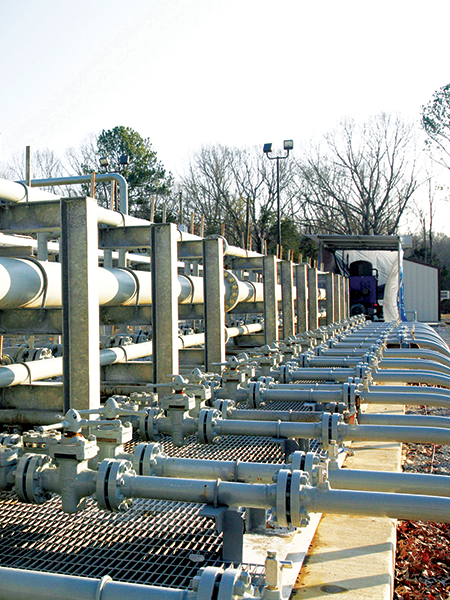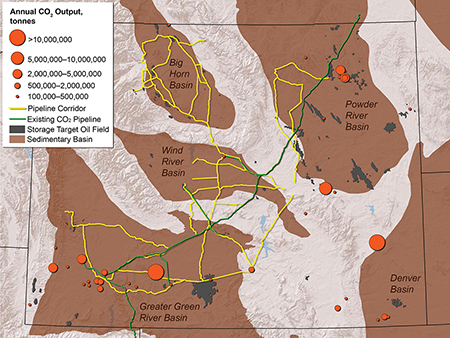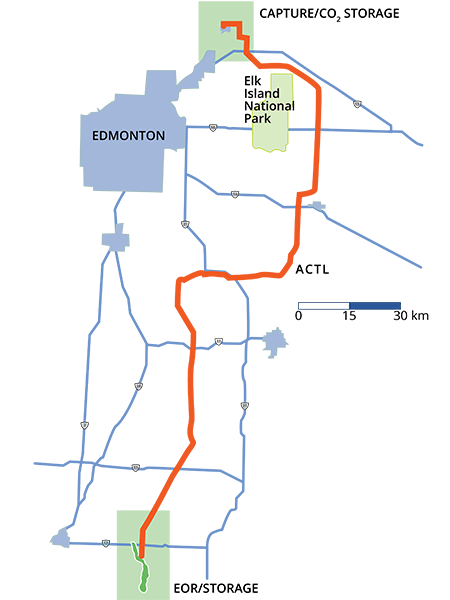Following capture and compression, CO2 is transported to a storage site. Given the quantities of CO2 that are likely to be captured from industrial sources, pipelines are the most efficient mode for transporting the captured gas to geologic storage sites. More than 8000 km (5000 miles) of CO2 pipeline is currently in service in North America, with additional pipeline planned or under construction.
Pipelines
For over 30 years, pipelines have safely transported industrial quantities of CO2. Although similar in design and operation to natural gas pipelines, CO2 pipelines require using thicker-walled carbon steel pipe in construction to accommodate the higher pressures needed for CO2 transportation.

Building a regional CO2 pipeline infrastructure for carbon capture, utilization, and storage (CCUS) activities will require thoughtful planning. Pipelines may be built to connect individual CO2 sources and storage sites in a “point-to-point” fashion; however, pipelines may also be used to connect multiple sources and storage sites in a network. Network options may offer reduced overall costs, but common carrier issues such as those related to CO2 stream quality may need to be addressed.
Wyoming Pipeline Corridor Initiative

A notable example of facilitating infrastructure development in the PCOR Partnership region is the Wyoming Pipeline Corridor Initiative (WPCI), which was formed to promote the development of a network of CO2 pipelines throughout Wyoming for transportation of CO2 from emission sources (such as power plants) to suitable storage locations or for other uses (such as enhanced oil recovery).
Under the leadership of the Wyoming Governor’s Office, and in collaboration with researchers, industries, and other state agencies, WPCI proposes pipeline routes that would cover almost 2000 miles and cross federal, state, and private lands in central and eastern Wyoming. More than half of the proposed corridors are through Bureau of Land Management (BLM) land, and in January 2021, BLM approved the WPCI proposal to designate over 1000 miles to the pipeline network. This approval is expected to accelerate the development of pipeline projects by reducing the time and cost of permitting.
Infrastructure
Currently, the United States has the world’s most extensive CO2 pipeline network; however, more infrastructure could ensure widespread deployment of CCUS in the United States. For example, most large-scale CO2 sources in the PCOR Partnership region are not near large CO2 storage opportunities. Increasing CCUS adoption in the PCOR Partnership region will require cost-efficient transportation of captured CO2 to ideal geologic storage opportunity areas. Without the transport component, there is little incentive to pursue capture.

Instead of constructing many new point-to-point pipelines, a more strategic approach using prescribed trunk lines and connector pipelines would be economically advantageous for efficiently enabling widespread commercial CCUS deployment. For example, the Alberta Carbon Truck Line, which had strong Canadian government infrastructure support, was designed for future expansion of CCUS. The 240-km pipeline has nearly 90% available capacity to accommodate future CO2 sources. Two newly planned projects in the PCOR Partnership region involve developing industrial CCUS hubs with shared CO2 transport and storage infrastructure. The development of additional shared infrastructure such as pipelines can be a strong incentive to trigger new investments.